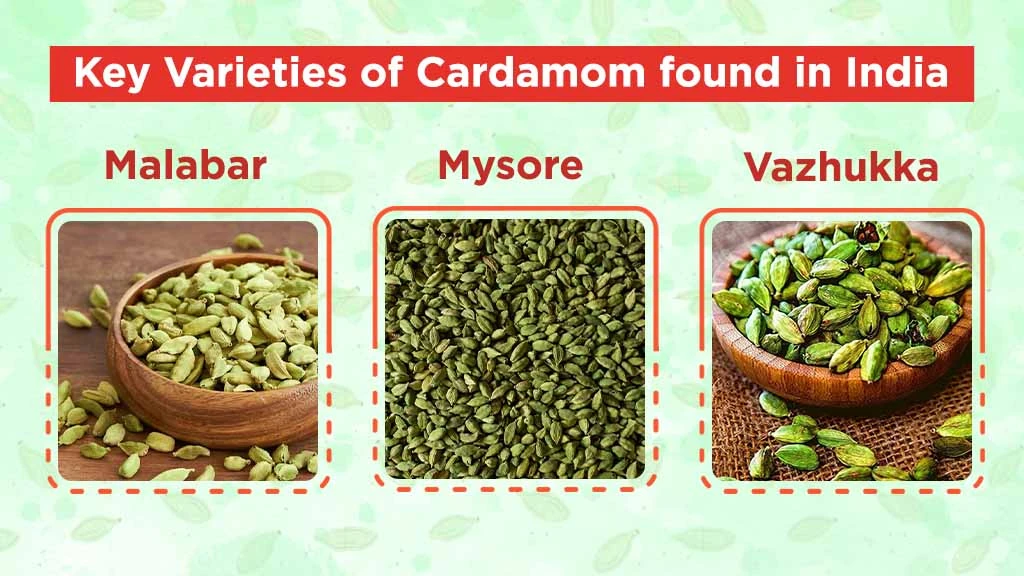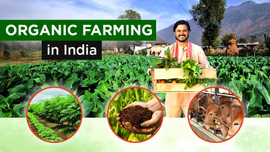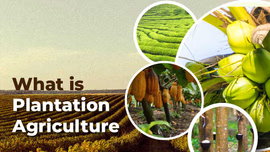Cardamom Cultivation in India: Varieties & Farming Practices

Cardamom cultivation is primarily practiced in the Western Ghats of Kerala, Karnataka, and Tamil Nadu. Cardamom is a high-value spice crop, and thus its cultivation is highly valuable for commercial farmers. India is among the top countries worldwide in cardamom production. Go through this article to learn everything about successfully growing cardamom in India.
Table of Contents
- Cardamom: Characteristics & Cultivation in India
- Different Varieties of Cardamom in India
- Cultivation Practices for Cardamom
Cardamom: Characteristics & Cultivation in India
Cardamom (Elettaria cardamomum Maton) belongs to the Zingiberaceae family. Cardamom (small) is a perennial, herbaceous, rhizomatous monocot that is native to the evergreen forests of the Western Ghats in South India. The Western Ghats are considered the cardamom origin. It is extensively grown at elevations of 800-1300 meters above sea level in the hilly regions of South India. Owing to its pleasant aroma and taste, cardamom is generally known as the ‘Queen of Spices’. The dried ripe fruit of the cardamom plant is used for commercial purposes.
According to the Spices Board India, the total cardamom production is estimated to be 20,696 tons for the year 2024-25. Also, the area under cultivation is noted to be 70,410 hectares. The top cardamom-producing states in India are Kerala, Karnataka, and Tamil Nadu.
The primary use of cardamom is to flavour a wide range of food preparations, beverages, and confectionery items. Additionally, cardamom oil and oleoresin are key ingredients in various medicinal remedies, as well as flavouring processed foods, liquors, and cordials. Cardamom is used to prepare Gahwa or Arabic Coffee, a cardamom-flavoured coffee, in Middle Eastern countries.
Different Varieties of Cardamom in India

The different varieties of the cardamom crop are extremely location specific. The two main types of cardamom plants include Elettaria cardamomum Maton var. major and Elettaria cardamomum Maton var. minor. The indigenous types of Sri Lanka are included in the major variety. The minor variety comprises cultivars such as Vazhukka, Malabar, and Mysore.
- Malabar: This plant can grow in areas with low rainfall and is at low risk of thrips infestation. It is a medium-sized plant that matures to reach a height of 2-3 m. Malabar has prostrate panicles and globose to oblong-shaped capsules. It thrives in areas with elevations of 600-1200 m.
- Mysore: This variety prefers assured, well-distributed rainfall and grows well at altitudes of 900-1200 m above mean sea level. Its robust plants grow to a height of 3-4 m on maturity. It has erect panicles and ovoid, bold, and dark green capsules.
- Vazhukka: It is considered a natural hybrid of Mysore and Malabar, and thus exhibits characteristics of both cultivars. This robust plant has deep green leaves, semi-erect panicles, and bold, globose or ovoid capsules. This cardamom variety grows at elevations of 900-1200 m above sea level and is commonly found in Tamil Nadu and Kerala.
Cultivation Practices for Cardamom
The following are the main considerations to be kept in mind for the successful cultivation of the cardamom crop in India:
Soil & Climate
Cardamom thrives in loamy soil and thick shady areas. Additionally, it grows well at elevations ranging from 600 to 1500 m. Heavy winds are not suitable for cardamom cultivation. This spice prefers forest loamy soils with proper drainage. The ideal soil for cardamom is acidic in nature with 5-6.5 pH range. It should have high nitrogen and organic matter content.
Sowing
The ideal cardamom plant growing time is June - December. The cardamom plant in India can be propagated by seedlings/suckers. Seeds are obtained from healthy, high-yielding plants. The seed rate is 600 g per hectare (fresh seeds). For 20 minutes, seeds are treated with commercial-grade Hydrochloric acid and Sulphuric acid and then washed with water.
Well-rotten cattle manure, wood ash, and jungle soil are used in equal quantities to prepare the beds. After sowing, a thin layer of fine sand is used to cover them. Seedbeds demand proper mulching and shading, and they should not be too wet but must be kept moist. It takes approximately a month after sowing for germination to begin, and then it continues for an additional 3 months. At the 3-4 leaf stage, transplanting of seedlings is done in the secondary nursery. In the secondary nursery, proper shading must be ensured. Seedlings are planted at a 20 x 20 cm distance. Suckers are mainly used for the purposes of gap filling.
Field Preparation & Spacing
The size of the pits to be dug is 60 cm x 60 cm x 60 cm. They are filled with compost and topsoil. In sloppy areas, contour farming can be performed. Old seedlings between 18-22 months are used for transplanting. For smaller varieties, the spacing should be 2 x 1.5 m, while it is 2.5 x 2 m for larger types.
Water & Nutrient Management
Cardamom is a rainfed crop. However, sprinkler irrigation can be used to increase yields during the summer season. Also, compost should be applied at the rate of 25 t/ha. Two split doses of 75 kg N, 75 kg P, and 150 kg K per hectare are incorporated during Jun ‑ Jul and Oct - Nov.
Post-Cultivation
Shade regulation is ensured as follows: Moderate shade, 50-60%; Rainfed, 40–50%; Irrigated, 55-60%. Medium-sized shade trees, such as Vellakil, red cedar, konikonna, Thambahom, or Bolongi, are ideal for regulating shade.
Weeding is necessary as and when required. At the end of monsoon rainfall, digging/light raking and mulching are required for moisture conservation during the dry period. 10-15 bee hives can be established per hectare to enhance pollination.
Pest & Disease Management
Cardamom is highly susceptible to pests such as thrips, hairy caterpillars, shoot & fruit borers, mites, and diseases. Following are the ways to manage these pests -
|
Pests |
Control Method |
|
Thrips |
|
|
Hairy caterpillar |
Phosalone (35 EC 1 ml/lit.) |
|
Mites |
Dicofol (18.5 EC 2 ml/lit.) |
|
Shoot & fruit borer |
Establish pheromone trap @ 12 Nos/ha |
|
Nematode |
Nursery bed fumigation with 2 % Formalin or Methyl Bromide (@ 500 g/10 sq. m) |
Similarly, certain measures need to be taken for protection against a wide range of diseases. Mosaic or Katte disease is caused by the banana aphid and is known to impact the productivity of Cardamom. The control measure involves regular spraying Dimethoate 30 EC, Methyl demeton 25 EC, or Phosphomidon 86 WSC @ 750 ml/ha.
Before sowing, the nursery can be drenched with a mixture of Formaldehyde (1 litre) and water (50 litres) for 3 sq. m. Pythium can be controlled by applying 1% Bordeaux or 0.25% Mancozeb just after germination. After 15 days, 0.05% Carbendazim can be applied to control Rhizoctonia.
Cardamom Harvesting
Bearing in cardamom plants usually occurs two years after planting. Oct-Nov is the peak harvest period for most regions. Picking is done at a 15-25 day interval. Maximum green colour can be ensured by harvesting ripe capsules. Drying of harvested capsules is done under the sun or in a fuel kiln/electrical drier. Before drying, freshly harvested green cardamom capsules can be soaked in 2% washing soda so that the green colour is retained during drying. In the case of drier, a temperature range of 45-500 °C for 14-18 hours is recommended. The capsules can be dried overnight in a kiln at 50-600 °C. Any foreign matter can be removed by winnowing and rubbing dried capsules using a wire mesh, coir mat, or hands. After sorting them as per colour and size, they are kept in black polythene bags, which are then stored in wooden chambers. Cardamom yield per acre is noted to be 80-100 kg.
Elaichi cultivation is important for Indian farmers because of its high value and market demand. It is widely used in traditional medicines, cuisine, and perfumery. India is the second-largest producer of cardamom globally. Thus, it has high export potential and supports livelihoods and rural economies. Follow this guide to ensure high cardamom yield and boost your income.
Frequently Asked Questions On Cardamom Cultivation in India: Varieties & Farming Practices
1. How long does it take for the cardamom plant to bear fruits or green cardamom?
Cardamom plants are observed to begin bearing 2 years after planting.
2. Which crop is cardamom?
Cardamom is a spice crop.
3. Where is cardamom cultivated in India?
Cardamom is generally cultivated in the southern states of Tamil Nadu, Karnataka, and Kerala.
4. Which state in India is famous for cardamom?
Kerala is most famous for cardamom, being its leading producer in India.
5. What climate is best for cardamom?
Cardamom grows best in warm, humid, tropical evergreen forest conditions.
6. Why is cardamom expensive?
Cardamom is expensive because of limited suitable growing regions, labour-intensive harvesting, high global demand, and low yield.


Related Blogs












